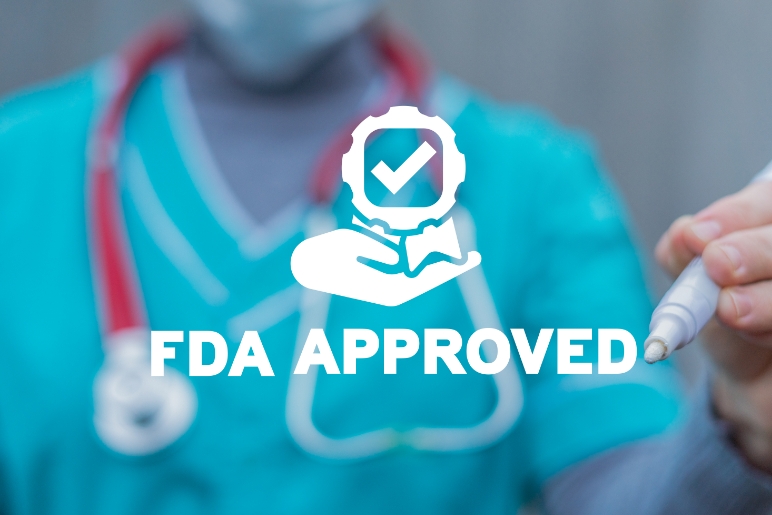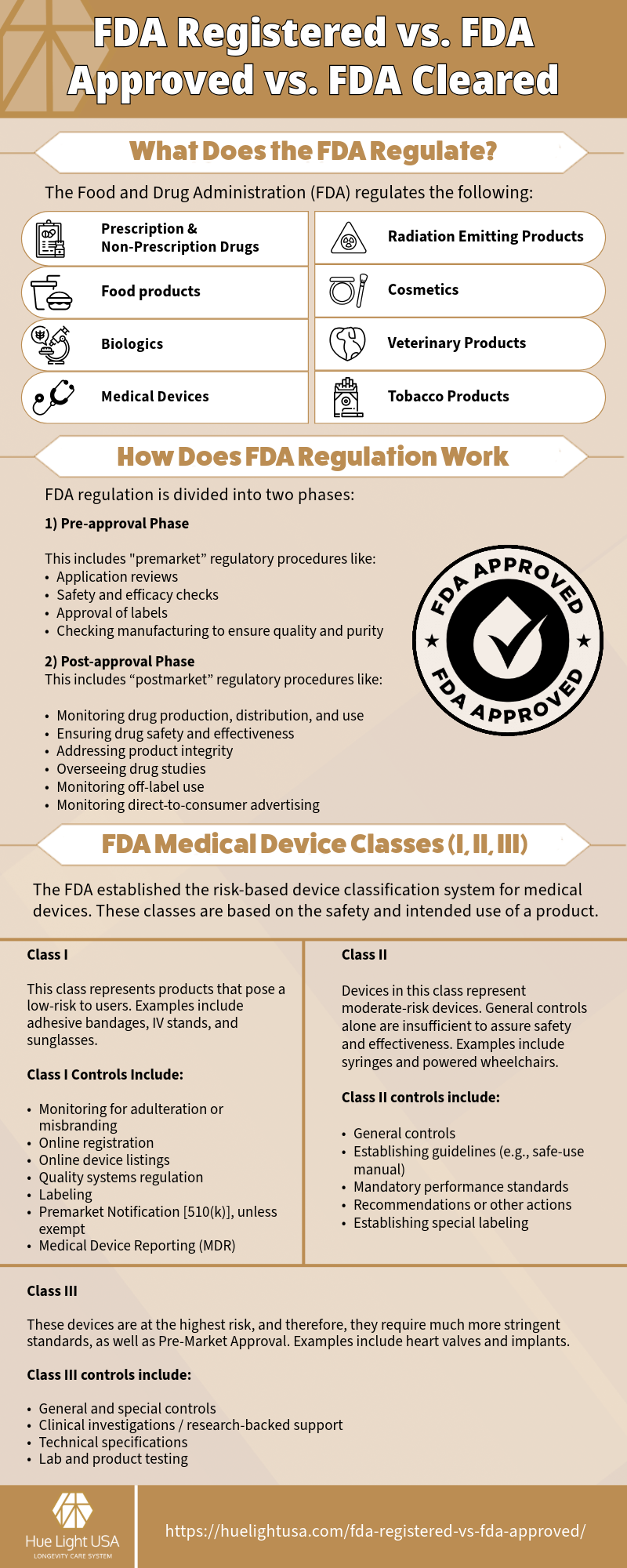
The field of healthcare and consumer products is complex and crucial for public safety. Among the myriad of regulatory bodies and systems, one acronym stands out for its importance and reach across every American’s dinner table and medicine cabinet – the FDA (the Food and Drug Administration).
In this deep-dive blog post, we will discuss FDA-registered vs FDA-approved vs FDA-cleared.
We will explore the essential categories of products under FDA jurisdiction and why these regulations are so vital for both enterprises and consumers. By the end, you’ll have a solid grasp of understanding, navigating, and explaining the ins and outs of FDA compliance.
Introduction to the FDA
The Food and Drug Administration is an agency within the U.S. Department of Health and Human Services. It’s responsible for protecting and promoting public health by regulating and supervising food safety, tobacco products, dietary supplements, prescription and over-the-counter pharmaceuticals, vaccines, medical devices, veterinary products, and more. With such a wide-ranging purview, the FDA’s oversight touches nearly every aspect of American life.
FDA-Registered vs FDA-Approved vs FDA-Cleared: A Overview

What Does the FDA Regulate?
The FDA oversees regulations in various areas, such as:
Food and Beverages
The FDA upholds safety standards and proper labeling for all food and drinks.
Drugs
Comprehensive oversight of the manufacture, sale, and use of prescription and non-prescription drugs.
Medical Devices
From band-aids to MRIs, the FDA ensures that devices are safe and effective.
Cosmetics
Regulations guide which kinds of products are allowed to be sold without prior approval and what claims can be made for their use.
Dietary Supplements
These products must adhere to specific rules and regulations set by the FDA.
Why FDA Regulation Matters
FDA compliance is the backbone of the consumer health chain. By establishing strict standards and protocols, the FDA has a crucial role in:
Ensuring Product Safety and Efficacy
By requiring studies and tests that prove a product’s benefits outweigh its risks.
Protecting Public Health from Harmful Substances
By staying vigilant and taking swift action to remove dangerous products from the market.
Providing Consumer Confidence in Products
With various levels of assurances (FDA-registered, FDA-approved, and and FDA-cleared), indicating the level of scrutiny a product has undergone.
How Does FDA Regulation Work?
Basic Process of FDA Approval
For a product to be FDA-compliant, it must undergo the appropriate regulatory process. This includes submitting an application, undergoing various stages of testing, and adhering to FDA guidelines throughout the product’s life cycle.
Understanding Key Terms and Concepts
Pre-market approval is often required for new products, involving a detailed review of the product’s safety and efficacy. Post-market surveillance is an ongoing process that monitors products after they are in use to detect any unforeseen issues.
Examples of FDA Regulations
The blanket term “FDA regulation” varies widely across product lines but shares the commonalities of stringent testing and oversight.
Labeling Requirements for Food and Beverages
Stringent guidelines inform everything from nutritional labeling to allergy warnings, and how products can be marketed.
Clinical Trials for New Drugs and Medical Devices
The FDA regulates the drug and device approval process, including adequate and well-controlled clinical trials, to ensure their safety and effectiveness.
Ingredient Safety for Cosmetics
Manufacturers must substantiate the safety of their products before selling, and any unsafe product can be removed from the market.
FDA Medical Device Classes (I, II, and III)
Device classes are set by the FDA. They are based on the level of risk they pose to the user. But also, the degree of regulatory control needed to ensure safety. Here’s a look at the FDA’s specific medical device classes:
Class I Medical Devices
- Risk Level: Low risk to the user.
- Examples: Elastic bandages, tongue depressors, and non-powered breast pumps.
- Regulation: Subject to general controls, and most are exempt from premarket notification requirements. Approximately 95% of Class I devices are exempt from regulatory processes.
Class II Medical Devices
- Risk Level: Medium risk.
- Examples: Motorized wheelchairs, pregnancy test kits, dialysis equipment, many types of catheters, and the Apple Watch ECG app.
- Regulation: Require FDA clearance through the Premarket Notification 510(k) process, demonstrating that the device is substantially equivalent to a legally marketed predicate device. Some Class II devices are exempt from regulatory processes.
Class III Medical Devices
- Risk Level: High risk, often life-sustaining, implanted into the body, or pose a significant risk to the patient.
- Examples: Pacemakers, breast implants, replacement heart valves, and mechanical heart valves.
- Regulation: Require FDA approval through the Premarket Approval (PMA) process, where manufacturers must provide valid scientific evidence of the safety and effectiveness of the devices for their intended uses.
These classifications help in determining the level of regulatory scrutiny and approval process needed before the devices can be marketed and used in the United States.
FDA-Registered vs FDA-Approved vs FDA-Cleared
Depending on the medical device class, the device may be required to meet specific FDA requirements, e.g. FDA Cleared or FDA Approved. However, all medical device companies must first register with the FDA.
Here’s an overview of each of these terms:
FDA Registration
Medical device companies must register their products with the FDA. Registration means the FDA is aware of the manufacturer and their devices, but it does not imply effectiveness for specific treatment applications. The manufacturer cannot claim that the device is FDA-cleared or approved based on registration alone.
FDA Clearance
Class II devices, which are moderate-risk medical devices, require FDA clearance. Manufacturers meet this requirement by completing the Premarket Notification 510(k) process. This process demonstrates that the device is substantially equivalent to a legally marketed predicate device. However, some devices are exempt from the Premarket Notification process. Devices that are FDA-cleared cannot be marketed as “FDA-Approved.”
FDA Approval
The FDA requires approval for the highest-risk devices (Class III), such as mechanical heart valves and implantable infusion pumps. Manufacturers must demonstrate, with valid scientific evidence, that these devices are safe and effective for their intended uses. The FDA also requires approval for new medicines, vaccines, animal drugs, food additives, and human cells and tissues.
What Is the Difference Between FDA-Approved and FDA-Cleared?
These FDA designations are reserved for different types of devices. Class II devices earn FDA clearance, while Class III devices and products must earn FDA approval.
Compliance and Enforcement
The FDA takes non-compliance seriously and has a range of enforcement tools at its disposal:
Consequences of Non-Compliance
These may include various regulatory actions such as product recalls, the issuance of warning letters detailing non-compliance issues, and even potential criminal prosecution for severe violations of industry standards.
Inspections and Audits
The FDA regularly inspects facilities and audits records to ensure compliance with its regulations. Addressing non-compliance is vital for maintaining public trust in the regulated products and the FDA’s oversight.
Tips for Consumers
Navigating the world of FDA-regulated products can be complex, but here’s how consumers can stay informed:
Reading Product Labels
Learning to interpret the symbols and language on FDA-regulated product labels can provide important information about a product’s safety and efficacy.
Report Adverse Reactions
If you have an adverse reaction or experience a problem with an FDA-regulated product, reporting it to the FDA helps to identify potential issues and protect others.
Conclusion
FDA regulations are a bedrock of public health and consumer protection. By understanding the key differences between terms like FDA-registered, FDA-cleared, and FDA-approved, consumers can make wiser choices about the products they use. The FDA’s work is a continuous effort to ensure that products reaching the market are safe, effective, and comply with applicable laws and regulations.
Stay informed, be an advocate for your well-being, and trust in the regulatory processes that keep you safe.
Ready to check out what Hue Light USA has to offer? Check us out today!







